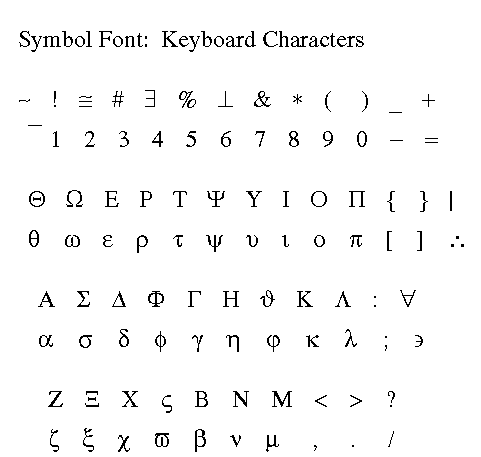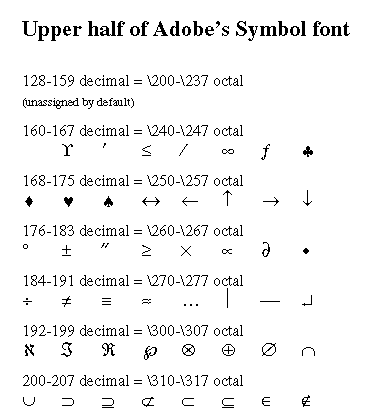
Back in the 1980s, when the Apple Laserwriter printer created the explosion of "desktop publishing", Symbol was on board, in one of the Adobe PostScript fonts that came bundled with the printer. PostScript is not just a collection of fonts, however, but rather an entire page description language. These days, Adobe Type 1 PostScript fonts (including Symbol) are still the industry standard at printing service bureaus.
Although Adobe fonts and equipment capable of running them were originally the domain of publishing professionals, too expensive for ordinary PC users on modest budgets, that is certainly no longer the case. The version I currently use came with Adobe Acrobat 3.0 for Windows, as a pair of Type 1 font files named sy______.pfb and sy______.pfm, which install in the acrobat3\distiller\fonts directory. These also come with Adobe's free Acroreader, and similar fonts are available in the freeware GhostScript and GhostView.
Microsoft also has a font called Symbol, and it too is widely available, coming bundled with MS-Windows operating systems. It is a TrueType font, in files named symbol.ttf and symbol.fot in the windows\system directory under Windows 3.1. Alas, this has a different character set than the Adobe font of the same name, with many moved or missing mathematical symbols, although like its namesake it does contain the entire Greek alphabet. In what follows herein, unless Microsoft is explicitly mentioned, "Symbol" refers to the Adobe font or the Adobe character set, since that is the one being proposed for use on the World Wide Web.
The never adopted and now expired HTML 3 proposal included provisions for <MATH> utilizing a character set based on the Adobe symbol characters. That was one of the things that was left out when a subset of HTML 3 actually was adopted and called HTML 3.2. Symbol or something close is being proposed again, at this writing, in an HTML 4 proposal, but it remains to be seen whether the leading software vendors will incorporate it into their browsers this time.
Symbol's main features are:
Note the distinction between "character set" and "font". It would be misleading to think of "Symbol" as just one item on some long list of fonts that might include such other fonts as Courier, Helvetica, and Times-Roman. The latter three differ in terms of the precise appearance of particular letters: Are the two branches of the letter "Y" of equal thickness? Do the branches of "Y" end bluntly, or flatten out into what are called "serifs"? Is "Y" wider than "I", or are all the characters of equal width? Those are the kinds of questions that distinguish such fonts as Courier, Helvetica, and Times-Roman from each other. But Symbol differs from all three; it does not even contain the letter "Y". It has the Greek letter "Psy" in the position where the others all have "Y". More generally, it has a different character set, with the Greek alphabet, Alpha through Omega, in positions where the others have the Roman alphabet, A through Z.
Perhaps it should be mentioned in passing that there are two other widely available fonts whose character sets differ fundamentally from the letters-and-numbers content of the Latin-1 character set: Wingdings, and Zapf Dingbats. These two contain various forms of stars, checkmarks, arrows, encircled numbers, etc. Symbol, in contrast, contains an extensive set of symbols used in mathematical expressions.
Characters in the lower half of the Symbol font can be entered
directly from the keyboard, when that is the active font, by
pressing the keys marked with their Roman counterparts. Alpha is
on the A key; Beta is on the B key; etc. Alpha and Beta resemble
their counterparts A and B in three different ways: alphabetic
position, sound, and character shape. In other cases, where the
three criteria diverge, sound, not alphabetic position,
and not shape, is the relevant criterion. Gamma, although the
third Greek letter, is on the G key, not the C key. Rho, although
shaped like P, is on the R key. And Omega, although the last
Greek letter, is on the W key, not the Z key. The entire keyboard
layout is as follows:

In addition to upper and lower case Greek letters, Symbol contains enough special characters to actually deserve the name "Symbol". A few of these are directly on the keyboard (e.g., the backwards E for "there exists" in place of the $ symbol on the shift of the 4 key). Most, however, must be entered some other way, the available ways depending on software context. Among the possibilities are:
The non-keyboard characters, whose decimal codes are between
128 and 255, are as follows:


Mathematical notation involves special characters, including those in the Symbol character set. But mathematical notation also involves other considerations, such as position of multiple levels of sub- or superscripts, or alignment of rows and columns in a matrix, or extension of brackets to fit oversized expressions they may enclose. The availability of an appropriate character set will solve many, but not all, of the problems faced in attempts to publish mathematical sociology on the Web. But it is an important step in that direction. And as this web page itself demonstrates, mathematical symbols can be posted on the Web now, without waiting for hoped-for features of future browser software.
Raggett, Dave, Jenny Lam, and Ian Alexander. 1996. HTML 3: Electronic Publishing on the World Wide Web. Reading: Addison-Wesley. Back
Smith, Ross. 1990. Learning PostScript: A Visual Approach. Berkeley: Peachpit Press. Back